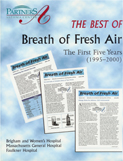Breath of Fresh Air: Feature Articles
Chapter 6: Monitoring Peak Flow
|
For the most part, we judge how our asthma is doing by how
our breathing feels. If we can take a full and satisfying
breath without cough or wheeze or tightness in the chest,
and if we can exert ourselves without excessive
breathlessness, then our asthma is quiet and we feel well.
If we are troubled by a cough, wheeze, tightness in the
chest, or labored breathing, we know that our asthma is
active and causing us discomfort. Often, it would be good to know more about how our
asthma is doing. It would be helpful if we could answer the
questions: Is an attack of asthma about to come on? Are our
symptoms due to a head cold or a flare up of our asthma or
both? Are our asthma symptoms serious or only a mild
irritation? A simple device is available to help answer these and
other questions about the status of our asthma: a peak flow
meter. Peak flow meters come in various shapes and sizes,
but the principle is the same for all of these devices.
Each records how fast we can blow air from our lungs. The
faster the air can exit from our lungs, the less active is
our asthma. The slower the air is exhaled, despite our best
effort to force it out rapidly, the narrower the air
passageways in our lungs have become and so, the worse our
asthma. |
Sometimes we want to know more about how our
asthma is doing than just how we
feel. |
|
|
Every person's best or target peak flow varies, depending on age, height, and gender. You can estimate the normal value predicted for a person of your age, height, and gender from the accompanying tables. Most persons with asthma when entirely well will have a value for their peak flow close to the normal value. To calculate
a "normal" value for a healthy person of a given age
and height, follow this link. Persons with diabetes can measure their blood sugar at
home to find out how well their diabetes is controlled and
to warn them if a problem is developing. They don't have to
wait to have their blood sugar measured at the doctor's
office. The same pertains to peak flow monitoring in
asthma. All that is required is a peak flow meter and your
rapid, forceful effort at blowing into it. Peak flow meters
can be purchased for about $20; no prescription is
necessary. For those who cannot afford the cost, our Asthma
Center will usually be able to provide you with one free of
charge. |
With peak flow meters we can measure our
breathing. |
|
|
To perform the peak flow test, take in a full, deep
breath, seal your lips tightly around the mouthpiece, and
blow as hard and fast as possible. The test is complete
after 1-2 seconds. We usually recommend repeating the test
two additional times and then recording the best of the
three efforts. |
||
|
One use for measuring your peak flow is discussed in the
accompanying article in Breath of Fresh Air [and next
chapter in this book] on asthma Action Plans. Many questions about peak flow monitoring remain. How
often should I measure my peak flow? What is the best time
of day to do it? Should I make measurements before or after
taking my bronchodilator medications? Do I need to do it if
I'm feeling fine? These and other questions can be
discussed with your doctor and are further addressed in a
pamphlet available at the Asthma Center, entitled "Asthma and Peak Flow
Monitoring." |
You can compare your own peak flow with
normal values and monitor for changes over
time. |

